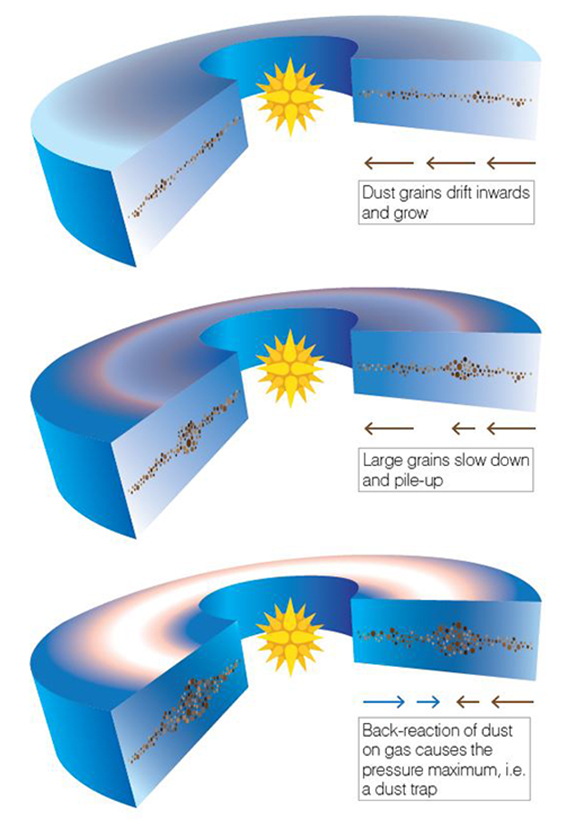.

An image of a protoplanetary disk, made using results from the new model, after the formation of a spontaneous dust trap. Credit: Jean-Francois Gonzalez
A French-UK-Australian team of astronomers may have discovered the missing link in planet formation that explains how initial dust develops into planetary systems.
Using numerical simulations and analytical calculations, researchers from Swinburne University of Technology, Lyon University and St Andrews University have developed a theory that explains the growth of solid particles from pebbles to planetesimals (asteroid-like bodies).
Their simulations show the formation of ‘dust traps’ where pebble-sized fragments collect and stick together, to grow into the building blocks of planets.
Planetary systems, such as our Solar system, began life as a disk of gas and dust grains around a young star. The processes that convert these tiny grains into larger aggregates a few centimetres in size, and the mechanism that converts kilometre-sized planetesimals into planetary cores are both reasonably well understood.
But the crucial intermediate stage, taking pebbles and joining them together into objects the size of asteroids, is less clear.
“There are two main barriers to pebbles becoming planetesimals,” says Swinburne Dean of Science, Professor Sarah Maddison. “Firstly the drag of gas on dust grains in a disk makes them drift rapidly towards the central star, where they are destroyed, leaving no material to form planets.
“The second challenge is that growing grains can be broken up in high-speed collisions into a large number of smaller pieces, thus reversing the aggregation process.”
Dust traps allow grains of dust to slow and accumulate
The only locations in planet forming disks where these problems can be overcome are in so-called ‘dust traps’. In these high-pressure regions, the drift motion slows, allowing dust grains to accumulate. With their reduced speed, the grains can also avoid fragmentation when they collide.
Until now, astronomers thought that dust traps could only exist in very specific environments, but the computer simulations run by the team indicate that they are very common.

The stages of the formation of dust traps. The central (yellow) star, surrounded by the protoplanetary (blue) disk. The dust grains make up the band running through the disk. Credit: © Volker Schubert.
“What we have been able to identify is the key role of the drag of dust on the gas,” Professor Maddison says.
“Often in astronomy, the gas tells the dust how to move, but when there is a lot of dust, the dust tells the gas how to move. This effect, known as aerodynamic drag back-reaction, is usually negligible. However, the effect becomes important in dust rich environments, like those found in the planet formation process.”
The effect of the back-reaction is to slow the inward drift of the grains, which gives them time to grow in size. Once large enough, the grains are their own masters, and the gas can no longer govern their motion. Under the influence of this back-reaction, the gas is pushed outwards to form a high-pressure region: the dust trap.
These spontaneous traps then concentrate the grains coming from the outer disk regions, creating a very dense ring of solids, and giving a helping hand to the formation of planets.
The results have been published in Monthly Notices of the Royal Astronomical Society.
Quelle: SWINBURNE
